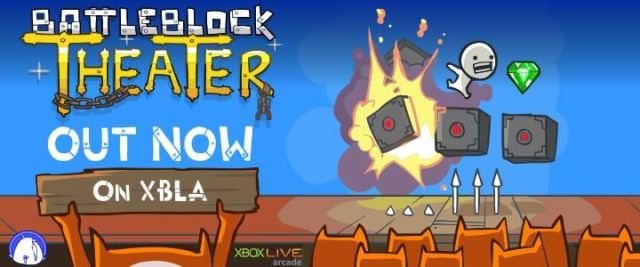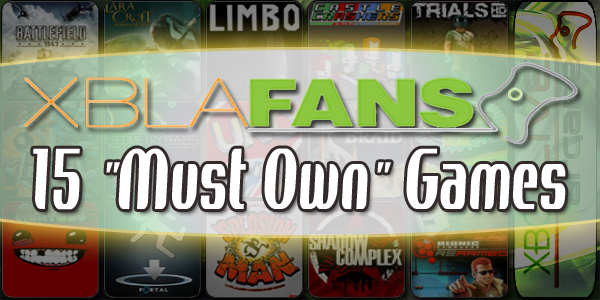It’s out now. For 1200 MSP, you can buy it and start playing it right away if you’d like. Funny thing about that, though — that should be old news. And it would be if The Behemoth had followed through with its plan to release BattleBlock Theater on XBLA back in 2010. Obviously, things didn’t quite work out that way, with the beat-em-up platformer having only just released yesterday. What happened? How could the developer have been so confident about 2010 that it was ready to tell the world that was the year and then ultimately be unable to finish BattleBlock Theater until three more calendar years passed it by?
Level Designer Ryan Horn has an explanation: the game wasn’t as fun as the team thought it was going to be. “I think we were hopeful about where the game was gonna be when we [planned] to release it,” he tells XBLAFans while sitting down for an interview at last month’s PAX East. “And then in between the time when we announced [the release window] and when we planned to release it at the time, we saw the game going in a direction that was fun, but we realized that we could take it in a slightly different direction that was going to be a lot more fun.”
With Horn having said his piece, studio President and co-founder John Baez expounds upon why The Behemoth felt its game could reach a state in 2010 that was up to The Behemoth’s considerably high standards of fun. Instead of going back to 2010, though, he looks a little deeper into his past. “The other component of [the delay] is that in our previous experience — I mean, Alien Hominid? Fifteen months, two consoles. Done out the door with an Xbox [version] following three months after that,” he begins. “And then Castle, it’s like, ‘OK, bigger game, three years.’” The prevailing feeling around The Behemoth’s San Diego office during the earlier development phase of Game #3, as BattleBlock was codenamed back then, was that it would not be as an ambitious of an undertaking as Castle Crashers.
BattleBlock‘s predecessor was “such a huge game,” that the developer couldn’t possibly forecast developing another game on that same scale. However, “once we started getting to the point of, ‘Wow, let’s go down this path instead of this path,'” explains Baez, “and it’s just a lot more fun, it just adds up — development time.
“And then the other big component is doing a show like [PAX East]. You go around here and Twisted Pixel and then the Indie Megabooth — we’re the only developers that are sitting in the booth. Everybody else is just marketing from Sony or Riot or whatever. They’re just the marketing guys. They’re not the level designers or whoever, and it adds appreciably to our game development time, except that we learn so much about the game having it here for three days getting fan feedback that it’s absolutely indispensable.”
Ugly knights and dead babies
Indispensable? It’s a strong word for the takeaway from the oft-derided game convention circuit. You hear some of members of the industry and the press making noise about their disdain for parts of — or sometimes even the entirety of — conventions while you’re at them. Come to think of it, you hear a lot of noise in general at conventions. As Baez speaks, I hear a megaphone-abusing League of Legends promoter about 50 yards away from us roaring important questions at desperate schwag hunters who are rubbing elbows in front of Riot Games’ booth. Questions like, “Who here is from Boston?!” The crowd eats it up and roars back. Internally, I briefly wonder how many in the crowd are actually from Boston, and how many will cheer for anything if there’s free schwag involved.
But The Behemoth doesn’t go to PAX to manufacture excitement or crowds. The Behemoth goes to show the games it’s manufacturing and to gauge players’ reactions to them — well, that and to sell copious amounts of merchandise. Usually the excitement and crowds form on their own, but not always.
“I think with…nothing has been more revealing than with Castle Crashers when we first showed that in 2005, and we did not get the fan reaction at all,” says Baez. “I mean, people were laughing, people were having a good time, but there wasn’t that, you know, ‘I don’t care how long the line is, I’m gonna stand here, and I’m not leaving until they kick me off.’
“And so we scrapped all of that work. It was about a year’s worth of work. Scrapped it. All of it. And [we] rewrote the gameplay engine and the graphics, so the original graphics of Castle Crashers looked very different.”
After telling him I remembered seeing the game’s early design, he describes it for me anyways, more succinctly than I likely would have. “Yeah, it was terrible,” says Baez. “But once we were able to just kill the baby, and just get on — that’s the most difficult part, because when you’re a developer you think, ‘Well, if I could just keep this thing alive a little bit longer it will all work out.’ What we’ve learned is, kill him and start over.”
Surviving murderous parents and making it to the block party
Killing something you’ve worked doggedly to create isn’t easy at first, but Baez and The Behemoth have learned how to do it. Did BattleBlock Theater have to snuffed out in its infancy, only to be reborn stronger, better? “Not like that,” says Baez. “Not that you could — because [Castle Crashers was] such a graphic change that you could just see the two of them. The way that it worked with BattleBlock, is just that it’s organic growth, and it sometimes got out of control, but I had to trim it a little bit, but the Ball Game example? That was going to get cut from the final build, and then we made that slight change, and everybody else in the office liked it, and then we put it in the beta, and then it was the most popular version.
“You know, we learn a lot about development from shows like this, but it takes time. But we’ve never had to do the serious hack-it-off-in-the-face with this that we did with Castle.”
I ask Baez to travel backwards through time with me once again, to take me to the moment when The Behemoth first showed Game #3 to the world. The year was 2009, and the place was the Tokyo International Anime Festival. Those not in attendance got their first look at the game when The Behemoth unleashed a trailer (above) during the show. Did The Behemoth get this one right? Did mistakes made rearing its older sibling teach them how to better prepare this young one for his introduction to the world?
“Visually there was enough there to keep going with. Yeah, totally,” says Baez. “Maybe less so in understanding the story component of the game. Originally it was kind of like, ‘Oh, you know, kind of Super Smash Brother-ey, platform-ey, a lot of different characters type thing.’ But then, you know, as it developed it was like, ‘OK, this is not going to be quick. It’s going to be a good, in-depth game process.'”
So, this game has, like, cats in it or something?
He mentions the story. It’s the only time we talk about it during our lengthy interview. It involves some sort of nefarious cat overlords forcing the player-characters to perform death-defying acts for their amusement…or something like that. Is any of that important to the game? Does the player have to become invested in the story to enjoy BattleBlock Theater?
“It’s how you play it,” explains Baez. “If you’re into story, that’s the game. But if you’re into the multiplayer — either sit on the couch or play online multiplayer — that is another huge part of the game. And if you’re that type of player you’ll be totally happy.”
He says that if you’re “that type of player,” you’ll enjoy “screwing with your friends, you know? ‘OK, go get me a beer! OK, no? Oh, bam! Dead!'”
I don’t bother taking the time to play BattleBlock Theater at PAX East 2013. Having played it at three previous cons and with the release date in sight at the time, there didn’t seem much need to do so. But it’s easy to relate to Baez’s hypothetical (?) situation between friends. When XBLAFans played his game at PAX East 2012, nary an opportunity was missed to kill each other. I ask if the game was purposefully developed to inspire griefing. “It’s always felt good. It’s always felt good,” he says. “It’s like beating up your little brother and not getting in trouble for it, that type of thing.”
It’s out now — what’s next?
Getting back to those dastardly cats and the game’s story, Horn explains that goofball premise for the game about blocks originally sprang forth from the “crazy-active imagination” of Lead Artist Dan Paladin. It grew from Paladin’s initial idea, though. It grew through the cooperative efforts of the entire team. “We all love gaming, and we all want our game to be as much fun as possible,” says Horn, “so if we have opinions about that it’s the kind of environment where we speak up and we talk about that. That builds ideas and gets results, I think.”
No more growing or building for now, though. Right now, Horn’s content to take it easy and watch “the baby go forth into the world.” Yesterday, the baby did so with the benefit of three years more of parenting then his procreators originally planned for.
Baez admits that while The Behemoth is always prototyping, another conception isn’t necessarily at the top of Horn and his to-do list. “I’m taking a breather. [Horn]’s taking a breather.”





